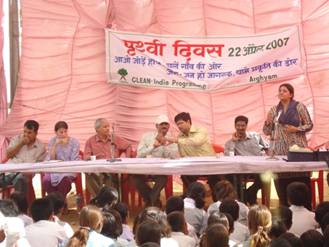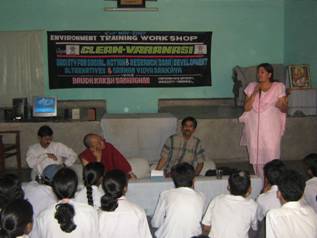Intoduction T he earth’s atmosphere was created by volcanic emissions of water vapour, carbon dioxide and other gases during the Precambrian era, and
this process continues. The earth’s atmosphere is mainly composed of
nitrogen, oxygen and argon (99.9%). Trace gases in it mostly include
water vapour, carbon dioxide, ozone and methane. The atmosphere has a
blanketing effect on the solar energy that reaches the earth, keeping
its surface temperature warmer by about 30º Celsius. Trace gases absorb
the thermal radiation emitted by the Earth and return it to the surface,
thus significantly reducing the loss of heat. This ongoing natural
process is known as the Greenhouse Effect.
vapour, carbon dioxide and other gases during the Precambrian era, and
this process continues. The earth’s atmosphere is mainly composed of
nitrogen, oxygen and argon (99.9%). Trace gases in it mostly include
water vapour, carbon dioxide, ozone and methane. The atmosphere has a
blanketing effect on the solar energy that reaches the earth, keeping
its surface temperature warmer by about 30º Celsius. Trace gases absorb
the thermal radiation emitted by the Earth and return it to the surface,
thus significantly reducing the loss of heat. This ongoing natural
process is known as the Greenhouse Effect.
Since climate change on Earth is a dynamic process affected by both terrestrial and extraterrestrial factors, the impact of the Greenhouse effect has also varied during long periods of geologic time, with corresponding heating up or cooling down periods and rises and falls in sea levels. There has been an overall trend of global warming as the Earth is currently still coming out of the last glaciation. During the 15,000 years of the Pleistocene period, the geoclimatic record indicates that—with the exception of a few short cooling cycles—there has been an overall pattern of global warming that has affected both the Earth’s climate and the sea level. The geoclimatic record of the last 400 years indicates a natural trend of increasing global temperatures and a corresponding rise in the sea level. For the last 100 years, global temperatures have been monitored reliably with the absolute rise being less than 1º Celsius. During that period; there was a short cooling period that lasted about 30 years. However, the trend reversed in the mid 1970s and global warming resumed. Finally, in the last twenty years, the rate of global warming has increased even more noticeably, with a rise in sea level and pronounced effects on the climate. For example, new measurements show that the flow of ice in the Greenland ice sheet has been accelerating since 1996 during the summer melt season. An increase in the anthropogenic input of greenhouse gases has been suspected to contribute to the accelerated global temperature increase, to the associated sea level rise, and to the higher frequency and intensity of weather-related disasters. Climate modelling studies generally estimate that global temperatures will rise in this century. Various models predict the temperature of the planet to increase between 1 and 5º Celsius in the coming 60 years. Such a warming is likely to raise the sea level by expanding the ocean water and melting glaciers and portions of the Ross and other Antarctic ice shelves and of the Greenland and Antarctic ice sheets. Climate Change and Weather-related Disasters Climate changes, global warming and a rising sea level appear to have serious adverse impacts on human and animal life on Earth and are the cause of great concern. The effect of global warming on weather patterns is frequently blamed for an apparent increase in both natural and anthropogenic factors. Stressors caused by such factors can affect marine resources in unpredictable ways. Extensive deforestation of large surface areas of the earth has resulted in significant changes in the water and radiation balance of the planet. Other apparent adverse anthropogenic impacts on climate include land-originating pollution due to increases in urbanization and industrialization and also rise in the use of fossil fuels. The resulting global warming and the rising sea level will have serious short and long-term impacts on human and animal life on our planet. The effects can be additive, synergistic or antagonistic. More frequently, they are harmful. Although little can be done to mitigate the adverse effects of natural climate change factors, much can be done to control the additional stress caused by anthropogenic contributions. The effect of global warming on weather patterns may also be responsible for an apparent increase in the frequency and intensity of weather-related disasters that are impacting upon mankind with relentless frequency and intensity and have taken a heavy toll in recent years. Similarly, man-made disasters caused by chemical spills, civil strife and wars not only constitute a clear and ever present danger for mankind, but may also have cumulative long-term effects on the climate. While all areas of the world are affected by climate change as well as natural, weather-related or man-made disasters, it is the lesser-developed countries which experience losses in human lives and economy disproportionate to their resources. Often, such major natural and man-made disasters result in complex humanitarian emergencies that seriously compromise the socio-economic development in affected nations and regions of the globe, creating escalating demands on rapidly diminishing international resources. Extenuation of Disasters by Awareness and Education The scientific consensus is that the observed warming of the Earth during the past half-century is mostly due to human emissions of greenhouse gases. Climate change may be the gravest calamity facing our species. Its worst likely consequence is to throw the world into food deficit, and therefore into perpetual humanitarian disaster. The only way in which we can prevent this is by reducing the consumption of fossil fuel. Total world emissions must be stabilized and reduced, with the rich nations taking the lead by making very large cuts within a few decades. That means big cuts right away. But it can’t happen unless there is a massively enhanced public awareness of the need for action. Perhaps the most significant barriers to GHG mitigation—and yet the greatest opportunities—are linked to social, cultural, and behavioural norms and aspirations. In particular, successes in GHG mitigation may well depend on understanding the social, cultural, and psychological forces that shape consumption patterns. Many people and organizations do not fully understand the benefits of energy efficiency. As people/institutions become aware of its benefits, conservation of energy resources will take place, and energy efficient technologies will be adopted. The use of more efficient technologies will, over time, increase energy intensity, curbing the emission levels. There are several implementation strategies to create awareness about climate change mitigation: n Educate policy makers on climate change issues to facilitate implementation of the mitigation actions for GHG reduction.n Work with community leaders from businesses, institutions, municipalities, universities, and colleges that have reduced GHG emissions in order to develop a critical mass of leaders in each sector who are reducing GHG emissions and making it a way of life in their communities. n Integrate climate change issues into curricula and outreach programming for future generations.n Identify community based organizations involved in outreach on climate change and related issues and expand participation to support all sectors in achieving goals for GHG emissions reductions.n Increase the awareness of the general public of the impact and problems of climate change and engage the general public in actions to reduce GHG emissions in both their personal and professional lives.There are very different levels of awareness of climate change in different sectors of the economy. For example, the water industry has included climate change as part of their long-term strategic planning for some time. Other key sectors for the underdeveloped nations have not yet considered the impact of a changing climate on their activities. Businesses need to be more aware of the potential impact in relation to profitability, marketing and potential new ventures. Raising public awareness on climate change and the likely future implications for our quality of life is an important responsibility. Individual actions such as water conservation within their own homes are important adaptive responses. In addition, the dissemination of information with regard to climate hazards such as flooding must be improved. Most people living in the floodplain are currently unaware of the risks. Outreach Through Students
To educate the students, different workshops, conferences, etc., can be organized which aim at providing a platform for children to learn about the environment through plenary sessions, and share views and concerns about the environment, climate change, forest and biodiversity, land degradation and desertification, water resources, waste management and recycling. They can also share their experiences on environment-friendly practices in life and learn from each other, through practical exercises, interaction, presentation and field trips. This kind of participatory learning is necessary: n To make children understand both the environment and environmental problems.n To utilize the unique position of school children as conduits for awareness of the society at large.n To facilitate children’s participation in decision making in areas related to environment and development. n To bring children into direct contact with the environmental problems facing the society they live in and make them think of solutions to the various issues. n To involve children in action-based programmes related to environment in their surroundings. Media Outreach The other most important way of outreach is to: n Work in association with the media to get newspaper editorials, and media coverage of climate change issues, action plan strategies, and instances of successful plan implementation.n Develop public service announcements to raise awareness. n Develop a documentary about climate change. n Incorporate existing climate change education into local public access programming. Climate-friendly technologies are essential for reducing emissions, but education, training, public awareness, outreach and institutional changes can certainly contribute and, thus, the impact of weather-related disasters could perhaps be mitigated. qDivya Sharma
|
 The
most important tool to this kind of education and awareness are the
students because they are the future and they can make their voices
heard as long as they want. To do so, there is a need to integrate
environment education in the curriculum, which can emphasize on climate
change and its mitigation. Once the students are empowered, they will
certainly lead this issue and replicate their knowledge to the
community. Also, they will spread whatever they learn.
The
most important tool to this kind of education and awareness are the
students because they are the future and they can make their voices
heard as long as they want. To do so, there is a need to integrate
environment education in the curriculum, which can emphasize on climate
change and its mitigation. Once the students are empowered, they will
certainly lead this issue and replicate their knowledge to the
community. Also, they will spread whatever they learn.